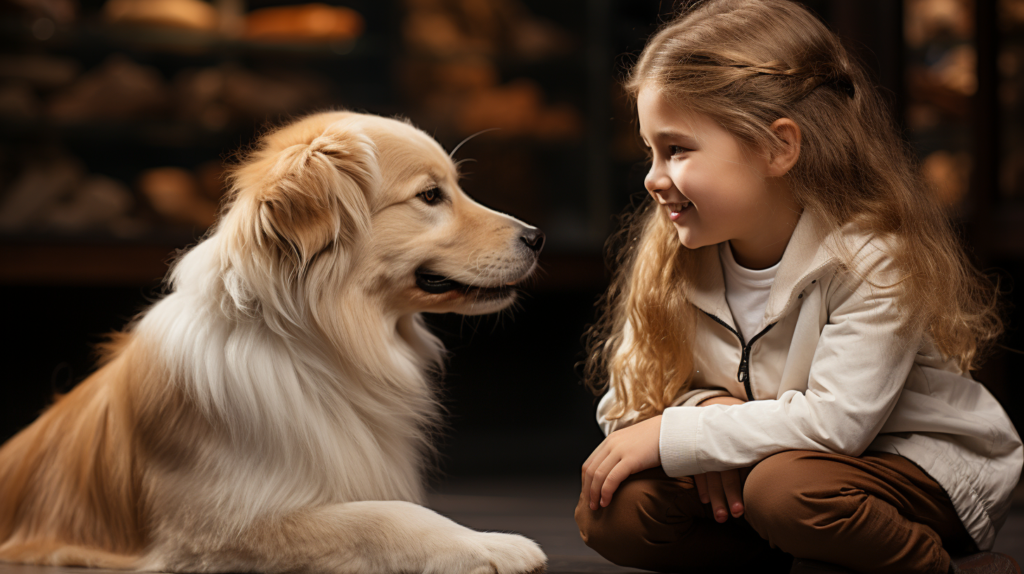Are you confused by what your pet is trying to tell you? It can be hard to interpret pet body language, but with a few clues, you can begin to understand their unique vocalizations and behavior. This article will discuss how you can confidently learn to interpret pet body language, so you can make sure your fur family members are always safe, happy, and fulfilled.
1. Unlocking the Secrets of Pet Body Language
Pets are wonderful companions with an even more marvelous array of body language. Learning to decipher these signals could give you insight on the emotional state your pet might be in. Here are a few tricks on how to unlock these secrets.
1. Keep an Eye on Ears and Tail – Changes in the position of the ears and tail are a great indicator of what your furry friend might be thinking. Ears and tail raised up typically indicate confidence and alertness. If the ears are laid back and the tail is tucked between the legs, your pet may be feeling scared or insecure.
2. Listen to the Sounds They Make – Observant pet owners can often tell when their companion is feeling unsettled or threatened by their vocalizations. Pay attention to the tone and the volume of their sounds and you should be able to get an idea of how they’re feeling at the moment.
3. Watch for Physical Contact – A pet experiencing higher emotions, such as excitement, will often display physical contact, such as leaning against people or pushing against them with their head. This can be a sign of affection. On the other hand, if your pet senses a threat and is looking to display dominance, they might take a step forward or stand upright to appear bigger.
- Noticing changes in body posture can give you an idea of how your pet might be feeling
- Vocalizations can give a lot of insight on their internal state
- Analyze the contact your pet has with you or others to see if they are friendly or dominant
If you pay close attention to how your pet moves and behaves, you should be able to tell when they’re uncomfortable. Learning more about pet body language might help you to become closer to your furry friend and strengthen your relationship.

2. Spotting the Telltale Signs of Stress and Comfort
Identifying Stress
Recognizing when someone is stressed out can be tricky. But there are certain signals that are always good clues. Some people may retreat into themselves when feeling overwhelmed, while others respond by becoming more active. Some telltale signs include:
- Agitation and tenseness
- Depression and apathy
- Insomnia or excessive tiredness
- Changes in eating habits
- Irritability
- Disorganization
Sometimes, these kinds of changes don’t necessarily indicate that someone is stressed out; they could also stem from physical or mental illnesses. That’s why it’s important to pay attention and look for other clues like changes in behavior, conversation, and even body language. If you suspect someone might be struggling, don’t be afraid to reach out and offer to help.
Providing Comfort
When it comes to providing comfort, it’s often as much about the actions as it is about the words. Taking time to connect and listen in a non-judgmental way can make a world of difference. Additionally, offering practical help like prepared meals or rides to appointments can be a huge help.
If you can’t provide physical help, simply being available to lend an ear and words of encouragement can be the difference between someone feeling isolated or understood. Ultimately, let the individual know they are cared for and that you won’t go away.
3. Reading Your Pet’s Emotional State
Pets have unique ways of communicating, and understanding their emotional cues to read their body language will help you create a better pet-parent relationship. Here are a few tips on .
- Location & Posture: Pay attention to where your pet is and how they are sitting or lying. Upright ears, leaning or sitting up, and close proximity to you can be signs of a happy, alert pet. Conversely, if they are stretched out, stressed, or have tucked their head and ears low, it may be a sign they feel uncomfortable or anxious.
- Facial Expressions & Eyes: Changes in your pet’s facial expressions can give away clues as to how they are feeling. Cocker Spaniels and other breeds with long ears may pull them back on their head when they are feeling submissive or scared. You can also watch if your pet’s eyes are soft or round, as this is often a sign of contentment. Red or tightened eyes are usually signs of discomfort.
- Vocal Cues: Although animals can’t talk, they can still make vocal sounds like barks, meows, growls, and hisses to communicate. Generally, loud noises are used to warn of potential danger, while softer vocalisations signify contentment. High-pitched whimpering may indicate fear, while a low or rumbling growl means your pet is feeling uncomfortable or threatened.
By understanding and learning to interpret your pet’s signals, you can stay attuned to their emotional state and better meet their needs. This helps to create an even stronger bond between you and your furry friend.

4. Understanding Tail Wags and Other Gestures
Dogs don’t have the same capacity for speech and language as we do, but they have their own means of communication to let us know how they are feeling. Learning to understand your pup’s body gestures and different tail wags is essential for understanding your canine companion.
Tail Position and Wagging
Your pup’s tail can tell you a lot about their state of mind. A tail in a relaxed position, not pointing straight up or tucked between their legs, generally denotes confidence and well-being. A neutral, half-way point between low and high generally tells the same. If their tail is up and steady, they may be ready for excitement or alerted to something else. But if the tail is wagging, it generally indicates that the beastie is feeling friendly, happy, or excited. If the tail is fast and stiff, it may signify a feeling of nervousness or aggression.
Other Body Language
- Yawning or lip licking can indicate stress or boredom.
- Turning their head away from you or averting their gaze can mean that they are feeling shy or anxious.
- Rubbing against you can show that they are content and seeking comfort and affection.
- A raised hackles can point to fearfulness or aggression.
The list of ways the pup may communicate with you goes on, so it is important to pay attention to different body signals that your pup may be giving and to learn what they normally prefer. Understanding these nuances is essential for getting to know your pup and establishing a bond that will last.
5. How Pets Communicate Through Facial Expressions
From hissing to meowing, all pets have their own distinct language and way of expressing themselves. Amongst these modes of communication, however, facial expression is perhaps one of the most vital. As pet owners, it is important that we can understand our furry friends and interpret their emotions through their facial expressions.
A pet’s face can tell us a great deal about his or her feelings. For example, a cat may give off a low, inhaling growl when confronted with an unfamiliar person or animal. Its eyes will be firmly shut and the corners of the mouth will be pulled down in an expressiion of displeasure. Alternatively, when feeling content a cat will purr and their face may remain relaxed and feature a slight half-smile.
Dogs also have quite the spectrum of expressions, ranging from happy to fearful. Signs of happiness may be identified when the dog’s ears are back, their tongue is happily lolling and the face holds an open, relaxed expression. If feeling scared, however, their eyes may appear wider with the mouth and nostrils held slightly open. This is often coupled with a slight tenseness in the muscles of their face.
- facial expression can be an important indicator your pet’s emotions
- when your pet is angry their expression may be hostile or aggressive
- when they are happy their expression may be relaxed, and feature a smile or gently wagging tail
6. Common Misunderstandings About Pet Body Language
A big part of understanding your pet’s behaviour lies in their body language. While some pet actions have universal meanings that are easily understood, others may be misinterpreted. It is important to become familiar with your pet’s particular nonverbal behaviours, as well as how they might be interpreted. Here are 6 .
- Purring – Many people assume that if a pet is purring, it is content or happy. In fact, purring may not always indicate pleasure. It can also be used to express pain, hunger or stress.
- Rolling over – Rolling over is an instinctive behaviour in some animals. Dogs in particular will roll over to show submission, in order to avoid physical confrontation. On the other hand, cats will sometimes roll over to get attention or even when greatly pleased.
- Yawning – We often think that yawning is an indication of tiredness or boredom in our pets. In reality, this is not always the case. Sometimes pets will yawn to calm themselves while stressed out or anxious.
Many pet owners believe that a pet who is staring directly into their eyes is simply trying to be affectionate. Staring can actually be a sign of aggression or confusion. Other signs such as tail-wagging can be misunderstood as well. Dogs may wag their tail to show pleasure, but they may also be doing it when excited, fearful or aggressive.
It is important to remember that pets have their own unique way of expressing their emotions. If you have any doubts as to what your pet might be trying to communicate, it is important to consult a veterinarian or a pet behaviour specialist for help. By understanding your pet’s body language, you can ensure that you are properly communicating your own feelings to them.

7. Reacting Appropriately to Body Language Cues
Body language is an incredibly powerful tool that can reveal a great deal of information about someone’s internal state. At the same time, our own body language messages can influence how another person behaves and how we interact with them. Whether you are talking one-on-one with another person, engaging in a group discussion, or delivering a presentation, being aware of and taking action on the other person’s body language cues is essential for successful communication.
When it comes to responding to body language, the first step is noticing what the other person is trying or not trying to communicate. Unspoken cues, such as posture, facial expressions, and nonverbal sounds, can convey a variety of emotions, such as friendliness, discomfort, or boredom. It’s important to note that body language is often not the only indication of emotion, so take time to consider other signs in order to form a better understanding.
Adapting your own body language is a critical part of reacting appropriately. If you want to build a good relationship with someone, maintain a friendly and open posture and make eye contact. During group discussions, take turns, listen attentively, and show your interest in different perspectives. If you are delivering a presentation, maintain a steady pace and don’t forget to use your arms and hands for emphasis on key points. Here are some other tips to keep in mind:
- Be aware of personal space boundaries according to culture.
- Allow pauses for the other person to process and respond.
- Smile in order to signal friendliness.
- Avoid fidgeting as it can be distracting.
By recognizing and using body language cues, you can effectively manage your own emotions and respond to others in a way that best serves your communication goals. With practice, you can learn to use body language more skillfully and become more successful in your interactions.
8. Interpreting your Pet’s Vocalizations
When it comes to understanding your pet’s vocalizations, the key is to listen to the nuances and pay attention to how and when their noises are used. Here are a few interpretations that may help you decode your pet’s language.
Yelps, Anguished Cries and High-Pitched Sounds: If your pet is in pain or emotional distress, they may vocalize yelps, anguished cries or other high-pitched sounds. This type of vocalization is typically accompanied by body language reflecting fear, submissiveness or other distress. It may indicate that your pet needs medical attention or is feeling threatened.
Whines, Low Grumbling and Soft Growls: These softer sounds may signify happiness or positive emotions. Whines and low pitched grumbling sounds can indicate that your pet is in contentment or feeling relaxed. They can also be used to indicate a desire for attention or even to express appreciation. Soft growls can simply be an excited or friendly way of greeting people or other animals in the house.
Barks and Huffs: Barks and huffs can be a sign of your pet’s alertness, indicating that they are on high alert and wants you to be aware of their environment. They may also be unhappily trying to get your attention or express their feelings of boredom and frustration.

9. Navigating New Situations with a Calm and Savvy Pet
An animal’s response to new situations is one of the biggest variables an owner must consider when interacting with their pet. It’s all too easy to get spooked or excited when a new thing presents itself; so it’s important to learn how to read the cues of your pet in these potentially tricky situations.
You’ll want to create a comfortable environment, as this will help make the process much easier. Be sure to monitor the way your pet displays its emotions through its body language and vocalizations. Be mindful of your own behavior, as excitement or stress can quickly transfer onto your furry friend.
To create an accepting environment, practice with your pet using positive reinforcement. Consider the use of treats as a reward for desirable behavior, and don’t yell or gesture too much. The goal is to have your pet identify whatever situation it’s in as a safe one and to grow familiar with it. Here are a few additional tips for navigating new situations:
- Stay mindful of your pet’s level of comfortability.
- Allow your pet to explore and become comfortable in its own time.
- Maintain consistency and remain patient.
- Avoid over-stimulating for longer periods of time.
- Make sure the environment is free from overcrowding or potential dangers.
10. Appreciating the Benefits of Confidently Interpreting Pet Body Language
Familiarizing Ourselves with Pet body Language
Pets communicate with us by using signals and body language. Much like humans, they express their feelings and emotions by using vocalizations, postures, facial expressions, and other physical displays. Understanding their behavior better gives us insight into how they process the world around them. To learn how to better interpret pet body language, start by studying pet books, magazines, videos and photos. The more we know, the better able we will be to read their body language and anticipate their behavior.
Watching for Subtle Cues
Every animal has its own personality and mannerisms. We can learn the subtle nuances in the way they communicate by paying close attention to the changes in their behavior. Recognizing a wagging tail or a pricked-up ear can help us to know when your pet is feeling relaxed or alert. Learning to identify a pet’s stress signs, such as signs of aggression or fear, can help us intervene before the situation escalates.
Benefiting from Better Communication
Interpreting a pet’s body language can help create stronger bonds with our pets. We can develop a better understanding of our pet’s wants and needs and can better meet their needs when we know what they are trying to communicate. Additionally, body language can help us to anticipate our pet’s behavior before it becomes an issue. Better communication based on an understanding of body language can help us lead more fulfilling relationships with our pets and keep our furry friends safe, healthy, and happy.
Your furry friends can’t speak to us but they do have their own unique ways of communicating with us. Now that you understand some of the ways in which our pets express themselves, being a mindful pet guardian is easier than ever. Pay attention to your pet’s behavior, and you’ll be able to read them like an open book!
